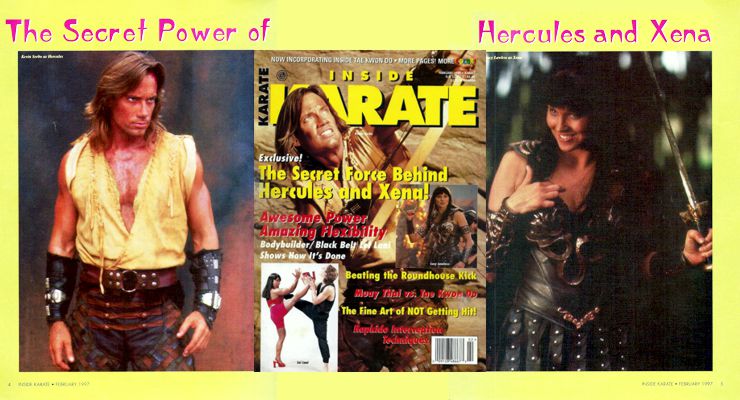Hercules: The Legendary Journey (1995) and Xena: Warrior Princess (1995) have become the second-most popular action series in the history of syndicated television (second only to “Star Trek”). Now, Doug Wong, trainer of series stars Kevin Sorbo and Lucy Lawless, reveals how he put the action in Universal’s “Action Pack”.
Venture with us now, to a time when television had become a vast waste-land. When programmers were petty and vindictive. When a yo-yo in a Gucci suits pet project took priority over the viewing public’s wants and needs. Into this world came the mighty Hercules and the warrior princess Xena, to tread the tyrannical Neilsen, lord of the air-waves, under their sandaled feet.
Since it premiered in January, 1995, Hercules: The Legendary Journeys has taken the television world by storm, and launched a trend in spin-off series, including its own spinoff, the equally popular “Xena: Warrior Princess.’ Audiences attribute the light-hearted humor and special effects to the popularity of the series. However, both Hercules and Xena also exhibit extensive martial arts prowess, and the fights scenes are far superior to those seen on the widescreen in today’s martial arts movies. The secret behind these two series is Douglas Wong, who trained both stars for their challenging martial arts scenes. Prior to being signed to their respective shows, both Kevin Sorbo and Lucy Lawless had marginal martial arts backgrounds.
The Trainer Tells All
“The biggest dilemma of any martial arts-oriented feature is the overall quality of the martial arts/film situation today,” says Doug Wong, at his Sit Lunt Kung-Fu Studio in Northridge, California, where he teaches his White Lotus system. “Real martial artists don’t have the best reputation as far as acting ability goes; the old ‘He’s an athlete, not an actor’ dilemma. That’s why studio execs, when it comes to the big budgets, are more inclined to cast a trained professional. When you’re going big budget or television, audiences won’t forgive wooden acting the way they will in a low budget film.
“It’s really all about expectations. If a film is a low budget martial arts movie, audiences see it for what it is and don’t have high expectations. The star doesn’t have to be that good-looking or charismatic. Really, most of the people who rent these videos are younger, and they fast forward to the fight scenes,” states Doug.
“When a movie goes theatrical or a television film, which is really a one-hour movie, is sent into the home, expectations rise,” he continues. “The characters have to look the part, and they have to be able to act. Where do you find a martial artist with that kind of ability?
“The Catch-22 is that most of the time, when you see professional actors who have trained for a role, they don’t look very good. Real martial arts training is based on time and experience. If it takes a minimum of four years for a person to make first-degree black belt in a lot of systems, how can you take someone and make him or her look like he or she has a lifetime of training in a couple of weeks?
“The answer is it can’t be done! Anyone’s kicks are going to be lame with less than two or three years practice. Most people need more. A warrior with a martial arts background has to have fighting skills that come as second nature. Regardless of what anyone says, the muscles have to be conditioned a certain way. the reflexes have to be made to respond a certain way, you have to achieve awesome flexibility. then practice, practice practice!”
So what is Douglas Wong’s secret formula for making a professional actor look like he’s had a lifetime of training? “It was tough.” he admits. “I’ve choreographed a lot of films and trained a lot of people. Then, one day, it hit me! It was there all along, as easy as ‘Wax-on, wax-off!'”
Relying on “Second Nature”
“Say you were to take a housekeeper, who spends five days a week scrubbing and polishing for hours,” Doug begins. All day long, she’s moving her arms in a circular motion, pressing hard with her hand. You stand in front of her and try to punch her, and teach her circular blocks. From her work, she’s going to be so fast that she’ll probably block every punch!”
Doug quickly realized he was on to something. “The Hawaiian boxers, who fought the Navy guys, were just about unbeatable. They’d hold their hands at a 45-degree angle and strike. They also spend almost all day out in the fields cutting sugar cane with knives held at the same angle.
“Ballet dancers are capable of leaps and spins no martial artist can match. People who play racquetball a lot develop sort of a reflexive dodging action, where they instinctively angle out of the way to avoid getting hit by the ball. Tennis players get that ‘turn-on-a-dime’ type of footwork. Volleyball players have an incredible sense of timing. Football players are good at running and dodging.
“It dawned on me that just about everyone has some sort of physical pastime or enjoys some kind of sport. In particular, in motion pictures, actors and actresses tend to be athletic. So if you find out what a performer specializes in, you can jump-start the training.”
Doug quickly realized that he had found the “missing link” in martial arts films: a way to quickly bring a professional performer up to speed. “If they’re into baseball, it’s easy to show them how to use a two-handed broadsword. They just wield it and swing it like a hat, and they can decapitate any dragon in record time! If they’re into tennis, you can teach them fencing moves. They’ve already got the body English and they can swing the sword like a racquet. It looks great on film against multiple attackers. If they swim, even the swimming moves and strokes can be trans-lated into strikes and blocks. They they’re a dancer, you’re home free with the kicks, and if they have a gymnastics background,there’s a world of things you can do.”
Armed with this discovery, Wong set out on his most ambitious project to date. This was the challenge of breathing life into Hercules and Xena.

Kevin “Hercules” Sorbo
Kevin Sorbo followed in some challenging footsteps, including those of the legendary Steve Reeves, when he undertook the role of Hercules. Sorbo’s portrayal was to be completely different than anything previously seen. This was to be a more “normal-looking” Hercules who, while muscular, was more human looking, without the “obviously cultivated” physique of a bodybuilder. His was to be a “good-guy’ Hercules, described as a “very human, accessible hero,” as decent and principled as he is strong.
Sorbo grew up in Mound, Minnesota, his father a teacher and his mother a for-mer nurse. He first decided he wanted to be an actor when he saw the musical “Oklahoma” at the age of 11. He played football in college, and began appearing on the stage. Arriving in Los Angeles in 1986, he quickly appeared in many commercials, and starred in several television pilots.
“Since Kevin already had an athletic background,” says Doug Wong. it was-n’t that hard to train him. Hercules usually fights a group, so his football days come in handy here, tearing through a number of attackers.
“I believe very much in realism because the way the weapons are supposed to be handled correctly is the way that the handling of the weapons evolved over hundred, maybe thousands of years. So the first thing I did was teach Kevin the basic principles and rules of every weapon. After that, we have to break the rules by introducing camera angles, from the rear, side, below, above, and straight into the camera.”
Lucy “Xena” Lawless
While Kevin Sorbo turned out to be a natural for Hercules, Lucy Lawless also proved to be a trainer’s dream. “Lucy looks the part, she’s almost six feet tall with long black hair and deep blue eyes,” says Doug, but she’s a completely different person from Xena. She’s very sweet. and speaks with a heavy New Zealand accent. The way she’s able to portray Xena with a U.S. based accent is amazing.
“She was formerly an opera singer. She also spent time as a goldminer in the Australian outback about 500 miles from Perth. She spent a lot of time right alongside the men, digging, mapping and driving the trucks. A of of the ‘roughing it’ background shows up in Xena.”
Lucy, who hails from Mt. Albert, New Zealand, where she lives with her husband and daughter, Daisy, wanted to portray Xena as the type of woman never before seen on the screen. She’s not good or benevolent by nature. but through choice.
“She’s a woman with a devil on her shoulder,” says Lucy, “who knows all about the darker side of human nature since she battles it within herself every day.” Xena is successfully portrayed as an exotic and fearless warrior trying to make amends for her dark past. Part of the magic behind Xena is her comedic sense, delivered by Lucy with flawless timing. Unlike Hercules, who has a reputation for being “Mr. Wholesome,” Xena must also battle her evil reputation, which has preceded her wherever she goes. When Hercules shows up in a trouble village, the reaction is “Help has arrived!” When Xena shows up it’s, “Oh, no! More trouble!”
Doug Wong found Lucy very easy to train. ‘She took to it like a fish to water. Because she’s so agile and athletic, I gave her an arsenal of techniques to use. Zena’s more the type who would subscribe the philosophy of a few techniques practiced to perfection are better than a lot of mediocre techniques. I drilled her in a lot of work with the staff, winch gave her total arm and body control, then taught her some specific advanced moves, like a back hook kick to the neck follow-up with a jumping inside crescent kick.”
The ratings on both of these series continue to rise, and they are also known for bringing in authentic martial artists, such as Karen Sheperd, to star in fight scenes. Thus, through two ancient legends, martial arts fans are finally being treated to the excitement they have craved for so long.
The Secret Power of Hercules and Zena By John Steven Soet – Inside Kung Fu Magazine February 1997








